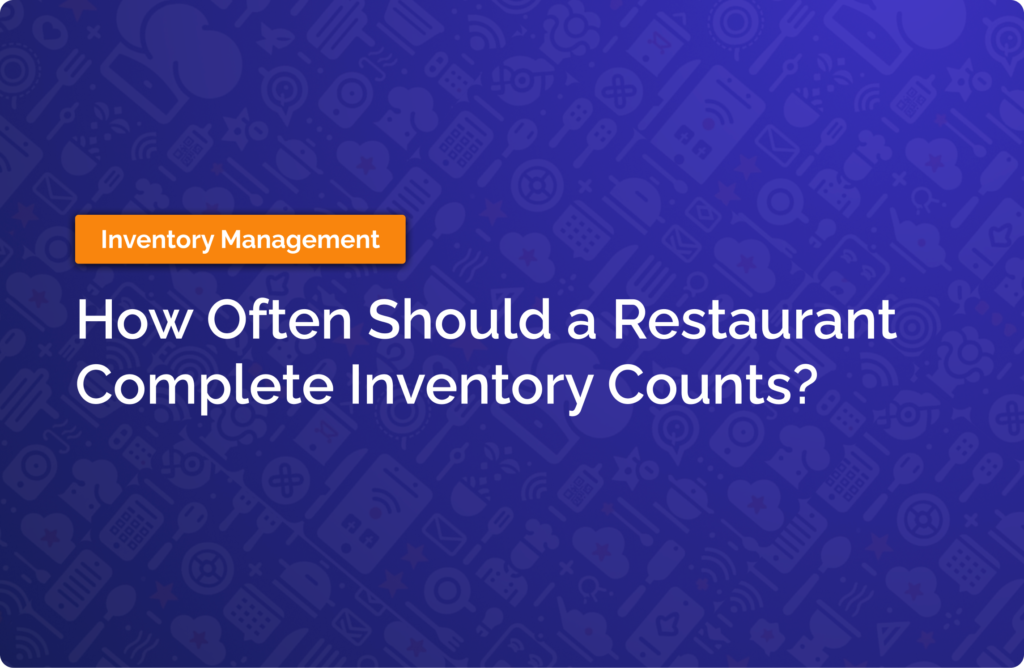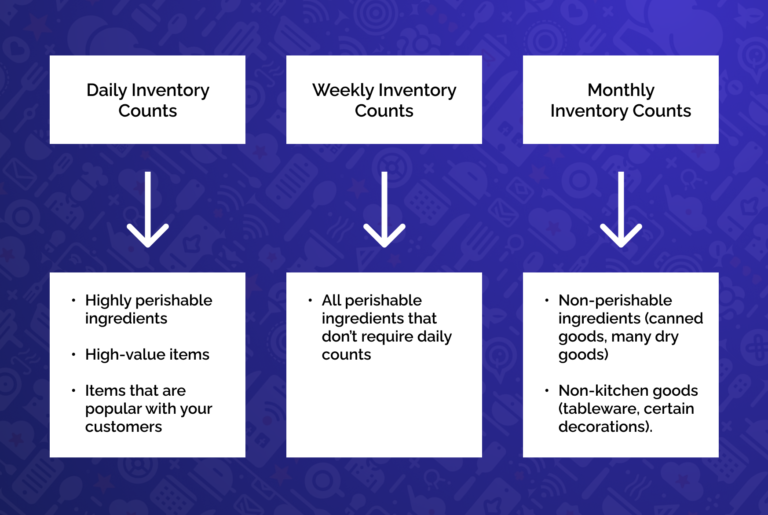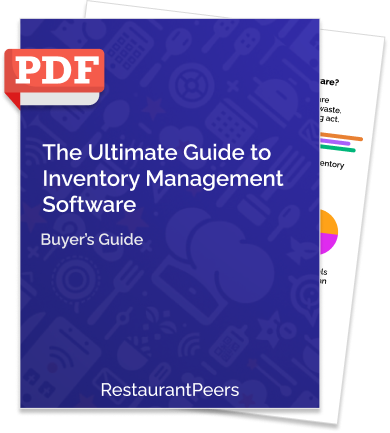
When figuring out how to go about managing inventory, one of the common questions among restaurant owners is how often inventory counts should be done.
The answer isn’t one-size-fits-all. It depends on a number of factors, including the restaurant’s suppliers and types of ingredients being counted, the type of restaurant, and the volume of the business.
By developing a well-planned inventory counting schedule, a restaurant can make sure that its inventory management efforts accomplish their main goal: to save the restaurant money.
This guide will explore the different frequency options a restaurant can choose between, offer practical insights and strategies to help you make an informed decision, and end with a real-world example from my experience conducting inventory as a chef at an full service restaurant.

What is an Inventory Count?
Before diving into the specifics, let’s first understand what an inventory count is and the kinds of stock items we’ll be counting as part of the inventory.
An inventory count is a process where a restaurant counts each item in its stock.
The purpose of inventory counting is to compare the actual quantities on hand against those recorded in the restaurant’s inventory system, which may be a digital, a spreadsheet, or manually recorded using pencil and paper. From there, the restaurant can make sound decisions on which items to order and how much of each to include in the order.
Inventory counts include both food and non-food items. Each requires a different approach.
- Food inventory involves all the perishable and non-perishable ingredients that a restaurant uses to prepare recipes. It’s dynamic, with stock levels constantly changing due to daily operations.
- Non-food inventory includes items like dining room supplies, cleaning supplies, and so on. These items have a longer shelf life and therefore don’t need to be counted as frequently.
What are the Frequency Options?
Restaurants can choose to count their inventory daily, weekly, or monthly.
Often, they’ll count different types of ingredients at different times, depending on what makes the most sense for each item.
For example, highly perishable ingredients might be put into one category and counted daily. Items with a longer shelf life, like dry goods, could be put into a different category and counted weekly.
Deciding on how often to perform inventory counts means looking at the pros and cons of different frequencies for each type of ingredient to find what best suits your restaurant’s needs.
Daily Inventory
Daily inventory checks work best for managing highly perishable ingredients, high-value items, or items that are popular with your customers.
For items that go bad fast, counting them daily helps a restaurant use them before they spoil.
High-value ingredients are often stars of a restaurant’s menu and can be what draws customers to your business. Keeping track of them daily ensures you always have them in stock so you don’t let your customers down by running out.
Also, counting valuable items daily can discourage theft by your staff, since you’ll know exactly how much of each item should be in the inventory each day.
Pros, cons, and when to use
- Pros: Maximizes freshness and reduces waste. Ensures you don’t run out of star ingredients and discourages theft of your high-value items.
- Cons: Time-consuming and may require additional labor.
- When to Use: Use daily inventory counts for highly perishable goods (think seafood or delicate herbs), high-value items, or items that are especially popular among your customers.
Weekly Inventory
Weekly inventory works best for all perishable ingredients that don’t require daily counts.
Since these ingredients don’t have a very high spoilage rate, you’ll be safer to count them weekly. And in doing so you’ll be creating a balanced process that saves both you and your staff time.
Pros, cons, and when to use
- Pros: Manageable for staff. Frequent enough for many ingredients that don’t spoil quickly. Allows for timely restocking of these ingredients. Gives the restaurant owner enough data to conduct robust inventory analysis and perform sound financial planning.
- Cons: May miss short-term fluctuations in stock levels.
- When to Use: For items with moderate shelf life or those used in steady quantities.
Monthly inventory
Monthly inventory is ideal for items that don’t require constant monitoring. This includes non-perishable ingredients (canned goods, many dry goods) and non-kitchen goods (tableware, certain decorations).
Doing monthly checks on these types of items will save your staff even more time.
Pros, cons, and when to use
- Pros: Saves time for staff on a day-to-day basis. Sufficient for goods that don’t spoil quickly.
- Cons: Longer gaps may lead to oversight of slow-moving items.
- When to Use: For non-perishable food items (canned goods, dry goods), non-food items (dining room items), and other supplies not directly tied to daily operations such as cleaning items.
Crafting the Optimal Inventory Schedule
Which Frequency Is Best?
In reality, a combination of all three frequencies offers the best results for most restaurants.
Using daily counts for highly perishable or fast-moving items ensures efficient use and reduces waste.
Weekly checks can maintain a good balance for the majority of stock that spoils less quickly.
And monthly counts are suitable for longer-lasting items.
This tiered approach allows restaurants to efficiently manage different types of inventory according to their specific needs and shelf life.

Taking your suppliers into account
Another factor that should be considered when choosing inventory frequency is who your suppliers are and what you order from them.
Many restaurants group the ingredients from a single supplier together and do a count on all of those goods at one time, regardless of the ingredients’ spoilage rates.
For example, let’s say you have a specialty supplier that provides both moderately-perishable items and also some dry goods that last longer. Counting all of these ingredients at once lets you send a single weekly order to that supplier for all of the items they provide, which can be more efficient.
Choose and stick to a schedule
Whatever frequency you end up choosing, it’s best to pick specific days for each check and to consistently do them on this schedule.
Sticking to specific days helps set expectations with staff members conducting the counts and lets them get into a rhythm.
It also makes your inventory data more clean and allows the restaurant owner to perform period-over-period analysis in an accurate way.
For example, you might choose to do daily checks for some ingredients, a Sunday check for weekly items, and a count on the last day of the month for monthly checks.
An example: How often I did inventory
When I worked as a chef in a restaurant, we had four main suppliers: a national food supplier, a specialty Asian food supplier, a specialty sushi fish supplier, and a different supplier for beverages.
To decide on our inventory schedule, we first broke down the ingredients by supplier.
The Asian food supplier had moderately perishable items, but nothing highly perishable, and so we counted those ingredients weekly.
The sushi fish supplier provided frozen fish from Japan which did not spoil quickly. We counted those ingredients on a bi-weekly basis.
For the beverage supplier, we did monthly counts since these items were non–perishable.
The national food supplier was a bit more complex. It provided the bulk of our ingredients. Some of these ingredients were more perishable than others.
We split these ingredients into three groups, and did different frequencies for each group.
The highly perishable ingredients (fresh seafood, dairy, and so on) got daily checks. The moderately perishable ingredients (most vegetables) got weekly checks. And the non-perishable ingredients (dry goods) were counted monthly.
Get the ultimate guide to inventory management software
- Inventory management software essentials
- What does inventory management software do?
- Signs you need this software
- How much money I can save & ROI

Software Helps
If all this seems tedious, it’s because it is.
Nowadays, there are a number of user-friendly inventory software solutions that will help make inventory counts less painful and more productive. Here are a few ways that this software can help.
More efficient counts
Using a strong inventory management software solution helps to make the process of performing counts more efficient for your staff.
More Accurate Counts
It also makes your counts more accurate, since identifying errors through software is much more straightforward than combing through spreadsheets or written inventory counts.
Prevents missing out on ingredients that need to be ordered
Beyond making the counts more efficient and accurate, the software will automatically identify ingredients that are running low and alert you that they need to be reordered. This way, you can be more confident that you won’t run out of any items.
Provides data and insights to save money
Data entered into the software will provide you with a number of valuable insights.
Which ingredients am I over-ordering? Which are prone to employee theft? Which am I under-ordering? Which recipes are the most and least profitable? Which ingredients should I stop purchasing and remove from my menu? Which recipes should I adjust for profitability?
All of these insights and more will steer you to take action in your inventory management processes. Most importantly, they will save your restaurant money.
If you haven’t started using inventory management software yet, we suggest giving it a look. There’s no rush to make a decision right away, but exploring what this software offers and getting a better understanding of how it can reduce your costs is a smart move for your business.
For a list of the top inventory management software solutions, including reviews of the providers, you can find our comprehensive guide on the software category here.